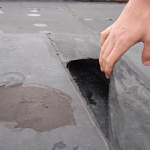How to Maintain your Roof
 Roofs, gutters and external walls need to be kept in good repair to protect the home. Basic roofing maintenance and repairs for example replacing tiles, are not difficult but it is essential to pay attention to safety. Most people prefer to leave large projects involving external walls to a professional, but there are a few smaller jobs that are quite straightforward. The most useful of these are pointing (repairing the mortar joints in brickwork) and patching up areas of rendering and pebbledash. Homes that are not well maintained are potential victims of damp. Signs of damp should be checked for regularly and treated immediately. Rot and woodworm treated immediately. Rot and woodworm diagnosed and treated in time.
Roofs, gutters and external walls need to be kept in good repair to protect the home. Basic roofing maintenance and repairs for example replacing tiles, are not difficult but it is essential to pay attention to safety. Most people prefer to leave large projects involving external walls to a professional, but there are a few smaller jobs that are quite straightforward. The most useful of these are pointing (repairing the mortar joints in brickwork) and patching up areas of rendering and pebbledash. Homes that are not well maintained are potential victims of damp. Signs of damp should be checked for regularly and treated immediately. Rot and woodworm treated immediately. Rot and woodworm diagnosed and treated in time.
The roof is one of the most important parts of any building. If you keep it in good condition it will protect your home from wind and rain preventing damp from getting into rooms below and rot from establishing itself in the timbers. Because of their exposed position roofs often need repair. Tiles and slates get damaged and the covering of flat roofs starts to crack. The gutters, which are important m keeping rainwater away from the walls and stopping damp, should also be kept in replacing slates and tiles, are not difficult, as long as you pay attention to safety.
Tools and materials
The main tools used for repairing roofs are a hammer and nails for fixing slates and tiles in place and a bricklayers’ trowel for removing broken tiles. A slaters’ rip is a more specialised tool used specifically for removing old slates. An ordinary gardening trowel is useful for clearing blocked gutters, while the best way of cleaning swan necks and down pipes is with flexible drain-clearing rods. A screwdriver and – screws are used for fixing gutter support brackets to the fascia board.
Ladders
To gain access to roofs and gutters, you win need a ladder or scaffolding tower and, possibly a roof ladder. Choose a double or triple extending ladder. A triple extending ladder is easier to store and to erect single’ handed. Aluminium alloy ladders are lighter than timber ladders. The treads should be wide enough for comfort and positioned so that they form fiat surfaces when the ladder is at the correct angle. At the top and bottom of each section there should be rubber safety grips, so that the ladder cannot slip.
Scaffolding towers cost more than ladders, but they can be hired. They take longer to erect than a ladder and are more difficult to move, but they provide a working platform that is safe and secure. They are essential for extensive roof work and gutter replacement, and useful for other work on roofs, gutters, external walls and upper-floor windows.
Roof ladders are essential for work on all roofs except the flat bitumen-felt type. They are usually made of light aluminium alloy, and have small wheels that enable the ladder to be pushed up the roof to the ridge. Roof ladders vary in length. Choose one that just fits the distance between the ridge and the eaves of your roof. They can be hired or, if you have a spare sectional ladder, you can convert it to a roof ladder using a bolt-on wheel-and-hook set.

 When you see this symbol you know you are dealing with a reputable roofing company
When you see this symbol you know you are dealing with a reputable roofing company